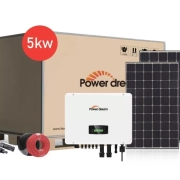How to plan a on grid solar system for a split-level home?
A comprehensive home energy consumption assessment is performed when planning an on grid solar system for a split-level home. Split-level homes often have dispersed floor space, multiple thermostat zones, and varying electrical loads. Next, a room-by-room review is conducted. Each floor’s area and usage patterns are determined: main living areas, bedrooms, and basement. Plans such as electric vehicle charging, home office expansion, or heat pump installation are also considered. These will affect the size of your home’s on grid solar system. The Energy Modeling Tool’s System Advisor model also simulates how the array will offset your energy consumption under local solar irradiation conditions. With an accurate analysis of daily and seasonal loads, you can specify a solar array capacity that reliably meets the needs of your split-level home.
On grid solar system: site analysis for multi-story roofs
Roof slopes may face different directions on different floors, affecting solar panels’ orientation and shading. First, the technician performs a detailed roof assessment by measuring the surface area of each roof plane, recording the slope angle, and identifying obstructions such as dormer windows, chimneys, or overhanging trees. Also, pay attention to shading on upper and lower roofs in the early morning and evening.
After collecting site data, the installer divides the rooftop into multiple zones. South-facing rooftops typically have the highest output, while east- and west-facing rooftops can supplement morning or afternoon loads. We consider installing distributed arrays on multiple roof levels for split-level homes to maximize energy capture efficiency and aesthetics. To ensure the structural integrity of each roof zone, the rafters and decking are verified to support the weight of the solar panels and mounting system.

On grid solar system panel layout design for split-level roof orientation
Optimizing solar panel location is key to maximizing system performance for split-level homes. In an on grid solar system tailored for multi-plane roofs, the installer must balance panel efficiency, aesthetics, and string configuration. First, consider south-facing solar panels because they reach peak power generation between 10 a.m. and 2 p.m. Then, add east—and west-facing arrays to smooth the daily output curve and capture low-angle sunlight during the morning and evening peaks.
Designers keep the string length consistent for each MPPT input on the inverter when designing a residential solar panel array. Avoid mixing solar panels from different roof planes in the exact string, as shading from one panel can reduce the output of the entire string. Installers can use separate MPPT channels or microinverters/power optimizers to minimize mismatch losses. Finally, consider future expandability: leave space on the south-facing roof for additional panels, ensuring your On grid solar system for residential use can scale if your energy needs grow.

Inverter Sizing and System Component Balance
For a split-level home using 25-50 kWh per day, a single-phase inverter rated between 8 kW and 12 kW is usually sufficient. However, if you’re generating more than 10 kW or your split-level design requires multiple panel orientations, you’ll want to consider a multi-MPPT or three-phase inverter to efficiently handle the different string inputs. Inverter efficiency ratings above 97% minimize conversion losses, ensuring your residential on grid solar system captures as much solar energy as possible.
In addition to installing the inverter, engineers typically integrate combiner boxes with built-in DC fuses to simplify string management. Furthermore, they select conduit solutions that comply with rapid shutdown standards to ensure the system meets NEC 2017/2020 safety regulations. Properly sized AC and DC circuit breakers protect the inverter and grid connection, and low-iron aluminum mounting systems are corrosion-resistant and durable, which is critical for segmented rooftop installations. By carefully sizing the inverter and BoS components, you can ensure that your residential split-level solar installation is safe, reliable, and compliant.
Power Integration and Utility Interconnection
For split-level homes, installers set the main service disconnect switch near the solar inverter and distribution board during installation to simplify interconnection. The utility company installs bidirectional or smart meters as needed to enable the Net Energy Metering (NEM) function, which compensates for excess production. In states without NEM, installers configure the inverter’s output limit according to local regulations to prevent grid line overloading.
IEEE 1547 and UL 1741 SA standards cover anti-islanding protection, voltage and frequency ride-through, and power factor control. We submit detailed single-line diagrams and equipment specification sheets to the utility for permit-to-operate (PTO) approval at installation, reducing interconnection delays and ensuring your split-level residential solar installation stays on schedule.
Performance Monitoring and Maintenance Strategy
Maximizing the life and efficiency of your on grid solar systems requires a proactive monitoring and maintenance plan. A real-time monitoring platform can track panel string voltage, inverter status, and generation trends.
Rooftop installations can be challenging for split-level homes. Choosing a module-level microinverter or optimizer allows remote diagnostics of individual solar panels, reducing the need for rooftop inspections. We recommend a semi-annual visual inspection for debris accumulation, roof fastener integrity, and new tree growth. Clean the panels with a soft brush and deionized water to maintain optimal performance, especially in dusty or pollen-prone areas.
Building a Split-Level House for Future-Proof Sustainability
Designing an on grid solar system for a split-level house requires a comprehensive approach: accurate energy analysis, detailed site assessment, optimized panel layout, precise inverters, and more combine to create a system that not only meets your current energy needs but also accommodates future growth.




